1973 Rugby VII
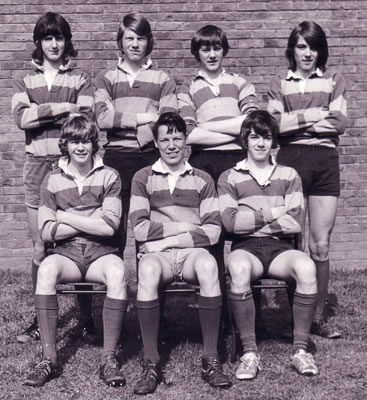
Back Row: Alan Botham, Paul Brewer, Ian Bentley, John Cartwright
Front Row: Tim Stubbs, Roger Yates, Graham Coleman
 |
|

Back Row: Alan Botham, Paul Brewer, Ian Bentley, John Cartwright
Front Row: Tim Stubbs, Roger Yates, Graham Coleman


By now, Mr. Robinson had been replaced by Sydney Wilson as headmaster. The school had ceased to be independent and was now a state run school but had a good name for sound, solid work.
The number of boys at the school had now reached three hundred for the first time. It now had a full staff allocation and could be considered to have completely recovered from WWI.

Click here to view large image
A few schoolmasters the likes of Herbert Pitchford, Joseph Hammond and George Cooper can be seen at the outset of their careers, little knowing that there would soon be another major war, or that they had such a long association with the school ahead of them.

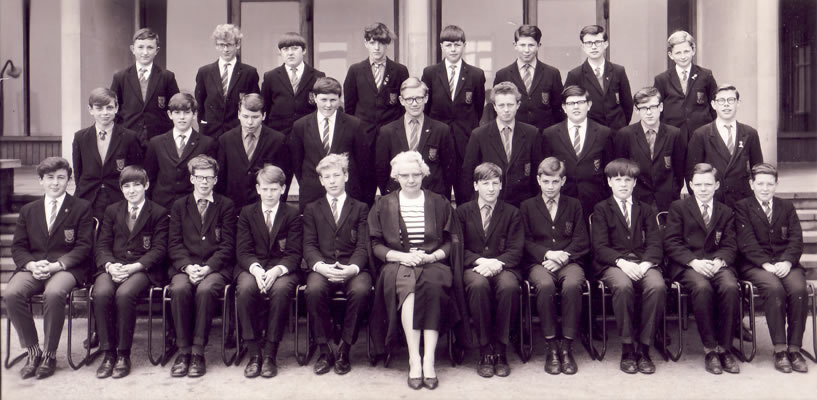
Back Row: Michael L Smith, Philip Shelton, Robert Longman, John Tucker, Donald Bauer, Paul Stockbridge, John Freeman, David Noble
Middle Row: Steven Wilcox, Chris Dytham, William Bradford, Peter Clemson, Iain Gray, Steve Hackett, Anthony Hardy, Michael J Smith, Stewart Cumpstone
Front row: Bernard Buckley, Kelvyn Bailey, Clive Smith, Nicholas Foston, Graham Loasby, G.E. ‘Fanny’ Radford (Form master), Ken Jordan, Bob Brooks, Glen Cooper, Kevin Fisher, Keith Foster


Back Row: Graham Howlett, Adrian van Daesdonck, Alastair Sutherland, John Chamberlain, Peter Shotton, Mick Street, Nick Pallett, Steven Elson, Peter Fisher, Philip Bell, Brian Moran, Brian Bond
Middle Row: Andrew Brown, Stephen Hadley, Howard Moore, George Sheldon, Barry Leedham, Stuart Arnold, David Jackson, John Bisbrowne, Robert Street, Dave Kennedy, Richard Hodgkins, Dave Field
Front row: Leo Howe, Robert Gould, Thompson, Andrew Vanables, David Bell, John ‘Jim’ Redmond (Form master), Philip Noble, Roy Bradley, Roddy Haigh, David Williams, Geoff Holden


Back Row: Robert Bull, David Clark, John Shilton, Ian Sutherland, Alan Newton, Mark Franklin, Andrew Woodland, Kevin Crisp, Christopher Dawes, Ian Haynes, Andrew Cheadle, Steven Lakin
Middle Row: Frank Burrows-Flowers, Graham Starmer, Chris Jerram, Ian Derrett, Stephen Taylor, ‘Doris’ Irving, John Wiggins, Brian Davis, Quentin Cubberley, David Glossop
Front row: Wall, Richard Hayes, Sam Williams, Ian Dilks, Andrew Livermore, Ron Illingworth (Form master), Peter Sherratt, Graham Parkinson, Charlie Holden, Bob Barnes, Rory Butler

My time at the school was spent from 1968 to 1973. Looking at this picture of most of the teaching staff taken in 1970 still conjures up some vivid memories some forty years later.
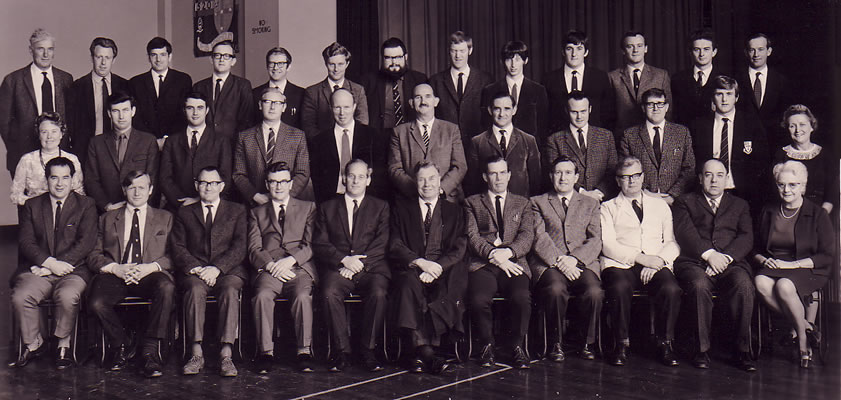
Back Row:
01. John Andrew (Tinman) – [Metalwork], 02. Colin Bagshaw (Bogwash) – [Physics], 03. John Long – [Latin], 04. David Wyatt – [Spanish], 05. John Sneyd – [Physics], 06. Alan Brewerton (Doc) – [Chemistry], 07. Robin Langton (Bumble) – [English/Literature], 08. Graham North – [History], 09. John Armstrong (Louis) – [Maths], 10. Alan Cure – [Geography], 11. John French (Frenchy) – [PE], 12. Chris Aylott – [Maths], 13. Michael Green (Ma) – [English/Economics]
Middle Row:
01. Barningham – [Office], 02. M02, 03. M03, 04. Chris Shepard (Shep) – [English], 05. Peter Dawe (Jackdaw) – [Music], 06. Harry Smith (Brab) – [Maths], 07. G.Davis (Taffy) – [Woodwork/Eng.Drawing], 08. Alan White (Chalky) – [English], 09. Brian Luckett (Chinner) – [Chemistry], 10. Robert James (Jessie) – [French/Latin], 11. Coates – [Office]
Front Row:
01. Walter Chadbourne (Walt) – [Physics], 02. Victor Roebuck (Vic) – [PE/English], 03. Ellick Ward (Ernie) – [French], 04. Hugh Wood (Woody) – [French], 05. Geoffrey Henton (Gaff) – [Geography], 06. Bill Gillion (Beak) – [Maths] *Headmaster, 07. Ron Illingworth (Ronnie) – [Geography], 08. Norman Jones – [Chemistry], 09. Ray Crowther (Joey) – [Biology], 10. Percy Barratt (Butch) – [History], 11. Elizabeth Radford (Fanny) – [Divinity/French]
Teacher |
Name |
Nickname |
Subject |
| Andrew | John | Tinman | Metalwork |
| Armstrong | John | Louis | Maths |
| Aylott | Chris | Maths | |
| Bagshaw | Colin | Bogwash | Physics |
| Barratt | Percy | Butch | History |
| Brewerton | Alan | Doc | Chemistry |
| Chadbourne | Walter | Walt | Physics |
| Crowther | Raymond | Joey | Biology |
| Cure | Alan | Geography | |
| Dawe | Peter | Jackdaw | Music |
| Davies | David | Taffy | Woodwork |
| Gillion | William | Beak | Headmaster |
| Green | Michael | Ma | English |
| Heath | Lewis | Chippy | Art |
| Henton | Geoff | Gaff | Geography |
| Illingworth | Ronald | Ronnie | Geography |
| James | Robert | Jesse | |
| Jones | Norman | Chemistry | |
| Langton | Robin | Bumble | English |
| Long | John | Charlie | Latin |
| Luckett | Brian | Chinner | Chemistry |
| Mart | David | Maths | |
| Meadowcroft | X | Modern Maths (assistant) | |
| Moore | James | Jomo | Maths |
| Morgan | Dil | Wingco | Geography |
| North | X | History | |
| Playll | Jack | Pleb | History |
| Radford | Elizabeth | Fanny | RE / French |
| Roebuck | Victor | Vic | PE |
| Shepard | Christopher | Shep | English |
| Smith | Harry | Brab | Maths |
| Sneyd | John | Sam | Physics |
| Ward | Ellick | Ernie | French |
| White | Alan | Chalky | English |
| Wood | Hugh | Woody | French |
| Wyatt | David | Spanish |
* grey simply donates that they did not teach me in the ‘B’ Class.


The school was split into four houses; Wellington (Maroon), Clive (Green), Drake (Blue) and Nelson (Black). So we each had to have a house sports shirt in the appropriate colour.
The wooden shields themselves took pride of place in the main hall with two either side of the main school shield.
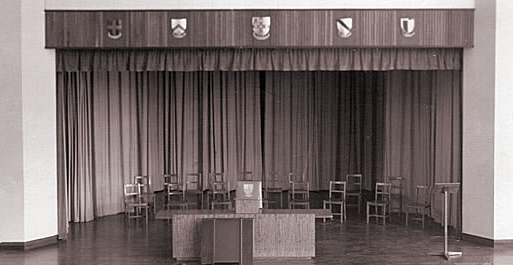
Looking at the House Shields rekindles the thoughts of how Clive looks somehow out of place and would be more fittingly depicted as a white shield with a green cross. I have not been able to find any genuine heraldic reasons to relate the four crests to their associated historic figures, neither have I been able to identify any other example where the same combination of shields is used so their origin remains a slight mystery; hopefully, I will be enlightened one day.

Seen here are two of the original wooden wall crests from the area in front of the library. While every effort has been made to restore the images, no attempt has been made to ‘graphically restore’ the conditions of the actual crests, which I remember being in much brighter condition.

In 1960, Headmaster Bill Gillion, with the co-opted help of Harry Smith, inaugurated a new form 5X. This was a special class was for the most gifted pupils of form 3A. It meant that the small group would study the fifth form syllabus, with the best available tutoring, in their fourth year to gain a year so that they would be able to study Open Scholarship, which went well beyond normal ‘A’ Level, in their year in the Upper Sixth rather than having to spend an addition year there.
The class was comprised of just twelve boys. Nine of the twelve gained places to Oxford or Cambridge Universities. To put this in context, Repton School achieved eight in the same year!
Sadly there was strong pressure, both internal and external, to look after the lesser able pupils rather than the brightest so the exercise was never repeated. Harry and other of the school’s most senior teachers saw this as the “start of the rot”.
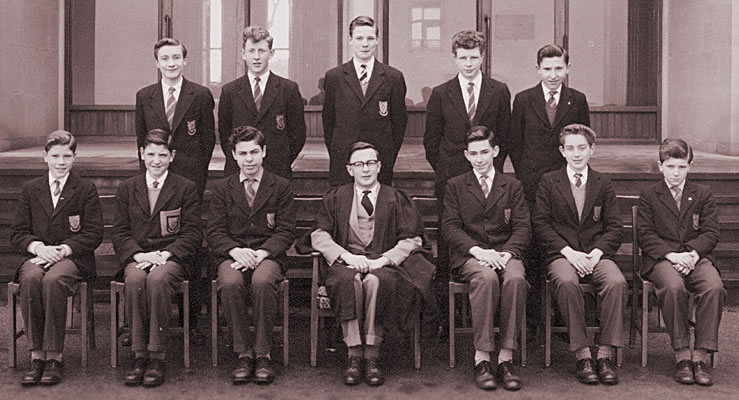
Christopher Tipper is the one pupil missing from the photo. It is thought that he went to Leeds University to he read Mathematics.
Top row from left to right:
Michael Green, studied Metallurgy at Oxford (New College) and now lives in the northern part of England. He visited classmate John Watson some time ago in Copenhagen in connection with some consultative work for IBM. He is still in contact with Roger Heape.
John Watson, studied Chemistry at Oxford (St. Edmund Hall), but converted to the computer industry and moved to Denmark for personal reasons in 1969. He has since worked for IBM for whom he has now worked for close to 40 years and still lives in Copenhagen with his wife Ida.
Roger Heape is considered a very central character. He was a fantastic DJ at John Watson’s 50th birthday in Copenhagen back in 1995 – his guests still talk about it, so many years after! Roger studied Geography at Cambridge (Pembroke College) and has had a lot to do with the Airlines business – BEA in the beginning and British Airways later on in a very top position. Roger has now retired and lives in Winchester together with his wife, Jenny.
Michael Hayton (aka Tudge) went to Cambridge (Churchill College) to study languages and went on to qualify as a Chartered Accountant.
David Allen was the only pupil in the class who did not go on to university.
Bottom Row from left to right:
Richard Inwood became Bishop of Bedford in 2003, however, he started his university career at Oxford (University College) studying Chemistry. (There are lots of web items to be found about Richard and some of them describe his career after Oxford).
Alan Stewart went to Oxford (St. Catherine’s College) and studied Metallurgy on an Exhibition Scholarship. He went on to do a PhD at Oxford before joining the CEGB (Central Electricity Generating Board as it was then).
Chris Howe went to Oxford (St. Edmund Hall) and also studied Metallurgy on an Exhibition Scholarship. He then went into the IT industry where he spent 20 years with ICL before retiring.
Arthur Presswell was the 5x form master and taught History. He did not spend long at the Grammar School and is thought to have come from Southend-on-Sea.
Alan Cooper went to Sheffield University and studied Geology. He also enjoyed an excellent Rugby Union career which included a number of England caps. He went to New Zealand to continue his studies. There, he went to Otago University. Despite not going to Oxbridge, he went on to become a professor (see http://www.otago.ac.nz/geology/afc.htm).
David Gooderick went to Cambridge (Emmanuel College) following which he did a teaching diploma at Oxford (Exter College) and went into teaching.
Chris Jeggo went to Oxford (St. Catherine’s College) on a Full Open Scholarship to study Physics. (articles on the web about him and contributed articles and photos to BGS). Chris moved into defence R&D in 1974 and has remained there ever since, working for a couple of different employers.
Teachers involved with 5x were:
English: Norman ‘Coddy’ Roe
French: Hugh Wood
Latin: Joseph ‘Jake’ Hammond
Spanish: (for the linguists): K.T. ‘Katie’ Harris
Maths: Harry ‘Brab’ Smith
Physics: Ezra Somekh
Chemistry: (for the scientists): Norman Jones
Geography: Ron ‘Ronnie’ Illingworth, and Geoffrey ‘Gaff’ Henton
History: Arthur ‘Elvis’ Presswell who also served as form master.
All pupils in 5x took at least eight ‘O’ levels.
Over 50 years later, a reunion lunch took place in Oxford with nine of the original members in attendance.

Burton Grammar School Master (Chemistry 1963 – 1975)
 Brian Luckett was born in 1940 in London, and evacuated first to Newquay, Cornwall and then in 1944 to the very contrasting Colne in North East Lancashire. He was to remain in Lancashire and, during his teenage years, lived close to Pendle Hill where he attended Colne Grammar School. He was a very keen Burnley supporter at this time, always watching them play on a Saturday afternoon, often having played rugby in the morning at school. To this day, despite no longer being able to name any of the players, he finds himself habitually checking on Burnley’s results.
Brian Luckett was born in 1940 in London, and evacuated first to Newquay, Cornwall and then in 1944 to the very contrasting Colne in North East Lancashire. He was to remain in Lancashire and, during his teenage years, lived close to Pendle Hill where he attended Colne Grammar School. He was a very keen Burnley supporter at this time, always watching them play on a Saturday afternoon, often having played rugby in the morning at school. To this day, despite no longer being able to name any of the players, he finds himself habitually checking on Burnley’s results.
Brian had a very influential chemistry teacher, who made chemistry very interesting and exciting and he opted to take it at ‘A’ Level with a view to reading it at University. It was working in the textile mills of Colne during his school holidays that made him want to specifically read Textile Chemistry . In the noisy environment of clattering looms, spinning and carding machines, he became a very good lip reader which, he claims, helped him on numerous occasions in the classroom!
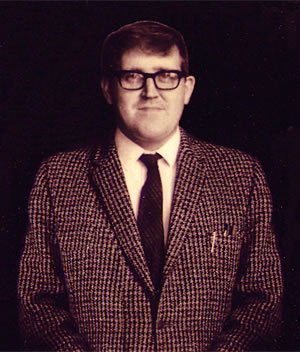 Brian obtained a BSc (Tech) degree in Textile Chemistry at the University of Manchester Institute of Science and Technology. At this time, the textile industry was going through a crisis and he decided to do a one year Postgraduate Certificate in Education at St. Luke’s College, Exeter. He had little chance of making the college rugby team though with the likes of Don Rutherford and Mike Davis (both future England captains) securing places. It was a much higher standard than the rugby he had enjoyed at school and university. His main teaching practice was at the Technical High School in Torquay.
Brian obtained a BSc (Tech) degree in Textile Chemistry at the University of Manchester Institute of Science and Technology. At this time, the textile industry was going through a crisis and he decided to do a one year Postgraduate Certificate in Education at St. Luke’s College, Exeter. He had little chance of making the college rugby team though with the likes of Don Rutherford and Mike Davis (both future England captains) securing places. It was a much higher standard than the rugby he had enjoyed at school and university. His main teaching practice was at the Technical High School in Torquay.
Mr Luckett had anticipated working in the south west but was attracted by a post at the Burton Grammar School in 1963 to replace the departing Dennis Grimsley which he applied for and was successfully appointed.
The Head of Chemistry was Norman Jones. Also teaching chemistry at the time was Gareth Woods with whom Brian found himself sharing a flat in Blackpool Street. Before long however, Mr Woods was to accept the post of Head of Chemistry at Soham Grammar School in Cambridgeshire meaning that Brian was promoted to second chemistry master and Mr C. Heighington was appointed third.
 Shortly after starting, he was persuaded by Headmaster, Bill Gillion, to take charge of Cross Country. It was a burden he was never really happy with although he can recall many fond times with the likes of Peter Rose, Robert Barningham and David Van Der Merwe in the first eight. In particular, he remembers “a small spindly lad called Chadfield” being a superb terrier who joined the Royal Navy and was found to have TB. He could well have competed at international level had he been treated earlier.
Shortly after starting, he was persuaded by Headmaster, Bill Gillion, to take charge of Cross Country. It was a burden he was never really happy with although he can recall many fond times with the likes of Peter Rose, Robert Barningham and David Van Der Merwe in the first eight. In particular, he remembers “a small spindly lad called Chadfield” being a superb terrier who joined the Royal Navy and was found to have TB. He could well have competed at international level had he been treated earlier.
He never actually ran round any of the courses, instead, he used to drive to the back of Newton Solney to shout support at the poor unfortunates (eminently more sensible). He even sympathised with those that took short cuts as he had done the same at his school, once falling in the canal. Brian was also happy to occasionally drive some of the chess team to away matches at other schools such as Bemrose, Derby School and Repton.
Brian recalls almost being expelled whilst in the 6th form for nearly setting fire to the school chemistry Lab! Having read that if you wrapped some sodium peroxide in wet newspaper it would ignite, he and a friend tried it but with little effect. The teacher, Mr ‘Aldophous’ Smith, shortly came into the laboratory and they threw the paper under a desk close to a radiator. Part way through the lesson, flames suddenly appeared as the correct moisture content was achieved.
With this in mind, he smiles at some of the ‘unofficial chemical experiments’ by pupils at the Grammar School during his time: The banned carbylamine reaction, on putting the constituent reactants down various sinks around the lab, when they all met up in the main drain, the really awful smell was generated in the lower corridor; the manufacture of highly explosive nitrogen tri-iodide powder to be distributed around the school. The staff had to pretend to be cross but couldn’t help but smile.
Brian reflects on what current day health and safety inspectors would make of boys sitting on their stools on top of the benches to watch the practical demonstrations without a safety screen. At the same time, he feels that the complete sanitisation greatly diluted the excitement of the subject that had encouraged previous scholars to take up careers within the chemical industry.
In 1966, Brian married Shirley, the Secretary of the Girls High School, at All Saints Church. Michael Thompson a pupil at the Grammar School played the organ at their wedding. The thought of this leads him to again reflect on many aspects of his time at Burton Grammar School which would seem incredible in the light of today’s educational system but which may well have defined the ethos of the school at that time: How well he, and other members of staff, got on with the boys and their families; how most teachers lived fairly close to the school without any thoughts of being in any way harassed by any of the pupils. He is sure that the chance meeting of boys and parents out of school was very healthy for the discipline and behaviour of school life. To this day, some forty years later, the Luckett’s are still occasionally visited by pupils or their parents, such as Peter Rose’s mother.
Like a number of schoolmasters, Brian also references the Burton Rugby Club as a bonding influence. Staff and pupils were given time off on numerous occasions to, for example, go and watch Burton play an Oxford University XV at Peel Croft, often featuring ex-pupils. It was also host to the Old Boys matches which kept the school’s rugby tradition alive.
On a couple of occasions, Mr Luckett tried to leave Burton Grammar School for higher posts in other schools but Bill Gillion, countered with the offer of a rise in the grading of his current post. He was never quite sure whether this was because of how highly the young staff were valued or whether the headmaster preferred the ‘devils he knew’.
In the early seventies he started the Wildlife Club on the request of pupils Beard and Eaton and, together with Colin Bagshaw, took boys on bird-watching trips to the Norfolk Broads, Slimbridge and other reserves – another “wouldn’t happen today”! ‘Plant a tree in 73’ was one of the catch phrases that helped the small group plant hundreds of trees at the RSPB bird reserve at Coombes Valley in North Staffordshire. To this day, he vows to one day go back to see how they have grown.
He left the school at the end of the final year of Burton Grammar School in 1975 after an offer by Jack Adams, who was a good friend of Norman Jones and the husband of Peggy Adams, head of Physics at the Girls High School, to be Head of Chemistry at Shelton Senior High School in Derby which he accepted. He had been offered the same post two years earlier but had been persuaded to stay.
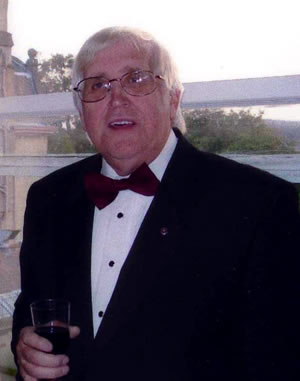 Brian was to remain there for fourteen years, before transferring to Wilmorton Tertiary College in 1989. He finally retired from teaching in 1995, but carried on marking ‘A’ Level Chemistry papers for the Cambridge Board for a further six years.
Brian was to remain there for fourteen years, before transferring to Wilmorton Tertiary College in 1989. He finally retired from teaching in 1995, but carried on marking ‘A’ Level Chemistry papers for the Cambridge Board for a further six years.
He looks back at his twelve years at Burton Grammar School as being the happiest of his thirty-two years in teaching and has never regretted taking up the post. The Lucketts and Bagshaws remain good friends together with the once assistant secretary of Burton Grammar School who was largely responsible for his meeting his wife.
Brian enjoys an active retirement being very keen on reading naval fact and fiction, pottering on his allotment and snoozing in his shed, family history, toy and model making and, at the time of writing, is President of the Ashby Rotary Club.
